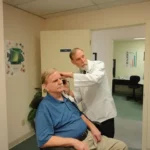Vertigo is a form of dizziness that is often described as a spinning or whirling sensation, leading to a loss of balance and coordination. It can be caused by a variety of factors, including inner ear disorders, medication side effects, and head injuries. In recent years, there has been some concern that red light therapy may also be a potential cause of vertigo. In this article, we will explore the science behind red light therapy and its potential effects on the vestibular system, which is responsible for our sense of balance and spatial orientation.
Red light therapy, also known as photobiomodulation, is a form of alternative medicine that uses low-level red light to treat various conditions. While this therapy has been known to have several health benefits, there have been concerns raised about the potential side effects of red light therapy, including vertigo. In this article, we explore the question of whether or not red light therapy can cause vertigo, and shed light on the research behind this issue.
Contents
Understanding Red Light Therapy
Red light therapy, also known as photobiomodulation, is a non-invasive treatment that uses low-level red light wavelengths to promote healing and reduce pain. The red light penetrates deep into the body’s tissues, stimulating the production of ATP, the energy source for cells. This increased energy production can help to promote cellular repair and regeneration, leading to improved tissue function and reduced pain.
Red light therapy has been used for a variety of conditions, including chronic pain, arthritis, skin conditions, and depression. It is generally considered safe and well-tolerated, with few side effects reported.
How Does Red Light Therapy Work?
Red light therapy works by stimulating the mitochondria in our cells, which are responsible for producing ATP. When the red light wavelengths penetrate the skin, they are absorbed by the mitochondria, leading to an increase in ATP production. This increased energy production can help to promote cellular repair and regeneration, leading to improved tissue function and reduced pain.
In addition to its effects on ATP production, red light therapy has also been shown to have anti-inflammatory effects. It can help to reduce the production of pro-inflammatory cytokines, which are molecules that are involved in the inflammatory response. By reducing inflammation, red light therapy can help to reduce pain and promote healing.
The Vestibular System and Balance
The vestibular system is a complex network of structures in the inner ear that is responsible for our sense of balance and spatial orientation. It includes the semicircular canals, which detect rotational movements of the head, and the otolith organs, which detect linear accelerations and changes in head position.
The vestibular system works in conjunction with other sensory systems, such as vision and proprioception, to help us maintain our balance and navigate our environment. When there is a disruption in the vestibular system, such as in the case of inner ear disorders, it can lead to symptoms such as vertigo, dizziness, and loss of balance.
Can Red Light Therapy Affect the Vestibular System?
There is currently limited research on the potential effects of red light therapy on the vestibular system. However, some studies have suggested that there may be a link between red light therapy and vertigo.
In a study published in the Journal of Physical Therapy Science, researchers investigated the effects of red light therapy on balance in older adults with balance impairments. They found that after a single session of red light therapy, there was a significant improvement in balance compared to a control group.
However, another study published in the Journal of Clinical Neuroscience reported a case of a patient who developed vertigo after undergoing red light therapy for chronic pain. The researchers suggested that the red light therapy may have caused a disruption in the patient’s vestibular system, leading to vertigo.
While these studies suggest that red light therapy may have some potential effects on the vestibular system, more research is needed to fully understand the relationship between red light therapy and vertigo.
FAQs: Can Red Light Therapy Cause Vertigo?
What is red light therapy?
Red light therapy, also known as photobiomodulation therapy, uses low-level light therapy to stimulate the body’s natural healing processes. It involves the use of red or near-infrared light to penetrate the skin and stimulate cellular activity. This therapy has been used for decades to treat various conditions such as chronic pain, inflammation, and skin conditions.
What is vertigo?
Vertigo is a condition that causes dizziness, a sensation of spinning or a feeling of being off-balance. It can also cause nausea or vomiting. Vertigo can occur due to various reasons such as inner ear problems, head injury, low blood pressure, or side effects of medications.
Can red light therapy cause vertigo?
No, red light therapy is not known to cause vertigo. There have been no reports of vertigo as a side effect or adverse reaction associated with red light therapy. In fact, some studies have shown that red light therapy may have beneficial effects in treating conditions that can cause vertigo.
What are the benefits of red light therapy?
Red light therapy has been shown to have numerous health benefits, including reducing inflammation, promoting tissue repair, improving skin health, and reducing pain. It has also been used to treat conditions such as arthritis, neuropathy, and depression.
Are there any side effects of red light therapy?
Red light therapy is generally considered safe and has few, if any, side effects. Some people may experience mild reactions such as temporary redness or a warming sensation on the skin. However, these effects are usually short-lived and do not require medical attention. It is always best to consult a healthcare professional before starting any new therapy, especially if you have underlying health conditions or are taking medications.






